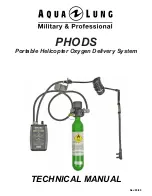
Impulse Tubing Length and Configuration
Impulse tubing is used to connect the sensing taps of the cone meter to the manifold connected to the differential pressure
transmitter One section of tubing should connect the high-pressure tap to the high-pressure side of the differential pressure
transmitter; another section of tubing should connect the low-pressure tap to the low-pressure side of the differential
pressure transmitter
• Impulse tubing should be installed with a gradient of 1:12
at a minimum to help prevent undesirable fluids from being
transferred to the differential pressure transmitter
• If tubing is installed in a horizontal orientation, install a gas/liquid separator device
• Avoid abrupt bends in impulse tubing
• If impulse tubing sections are long, use mounting brackets to support them
• Tubing length must be short enough for a high degree of accuracy, and long enough for proper cooling of
high-temperature fluids before they reach the transmitter
• Make sure the installation permits access to the connection tubes, valves, valve manifolds and transmitters
for maintenance
• Limit the number of fittings and avoid long tubing sections that can impair measurement accuracy and increase the risk
of plugging
• Avoid changes in tubing elevation Differences in elevation will cause a difference in the hydrostatic pressure of the liquid
column in the process lines, which can result in inaccurate differential pressure measurements Fasten the process lines
together, if possible, to keep their relative elevations consistent
• Install process lines so that they slope in only one direction (up or down) If piping must slope in more than one direction,
do not allow more than one bend Install a liquid or gas trap at the lowest point in a gas service installation Install gas trap
at the highest point in a liquid service installation
Straight Pipe Run Requirements
Page 12
June 2018
DPM-UM-00206-EN-03










































